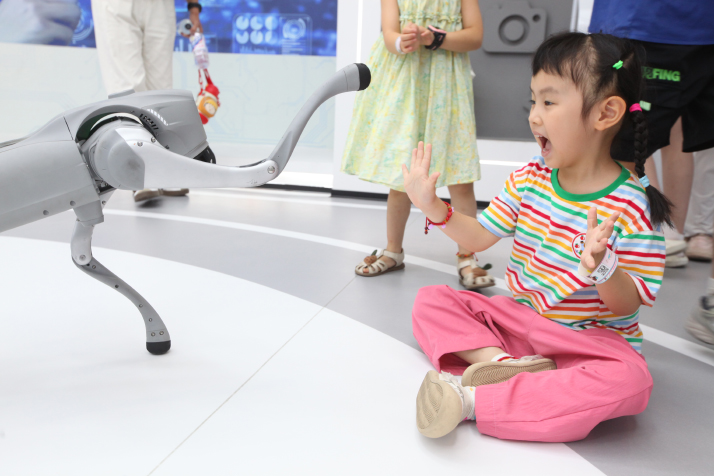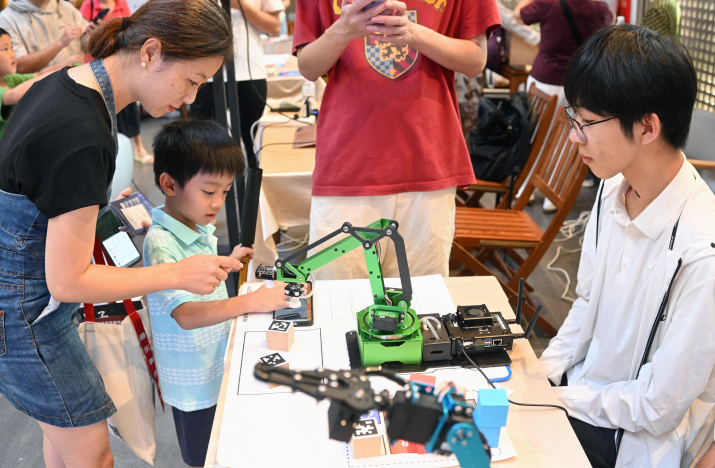| China |
| National Science Popularization Month brings cutting-edge tech and accessible learning to the public | |
|
|
 A child interacts with a robotic dog at a science museum in Xuzhou, Jiangsu Province, on September 7 (XINHUA)
Wang Yimei, a resident of Haikou, Hainan Province, drove two hours to Danzhou, another city in the province, so her child could take part in the 2025 Hainan Province National Science Popularization Month activities on September 6. "Building race car and rocket models with the teacher, we were very excited to learn about the scientific principles behind them. We'll come again next time there's an event like this," Wang told Hainan Daily newspaper. After the inaugural National Science Popularization Month in China started on September 1, Hainan launched an impressive 765 activities across the province, to spark public curiosity and boost scientific literacy. The Danzhou event showcased cutting-edge technologies, including an AI chess robot, which was a highlight. "Who will win in a game of chess between humans and robots?" Curious visitors watched as students sat at the chessboard, challenging the robot one after another. "This robot has mastered more than 1,000 chess strategies, allowing it to quickly find the optimal move," event staff member Zou Guansheng told Hainan Daily. Nearby, a robotic drummer captivated audiences. After a song was selected, the robot got into action, wielding drumsticks with precise, stable and powerful rhythms, while children danced to the music. "Relying on advanced algorithms, the robot has a 'super brain' capable of accurately analyzing musical scores and synchronizing movements of its head, hands and feet with precision. It can drum as fast as eight beats per second," another staff member said. These novel technological experiences sparked visitor Zhang Wen's strong interest in technology. With AI integrated into all aspects of life and work, "only by continuously learning and keeping pace with technological development can we create more innovative achievements and make life better," she told Hainan Daily.  Visitors examine a miniature robotic arm at a community exhibition in Shanghai during the National Science Popularization Month on September 13 (XINHUA)
Science literacy China has made significant strides in science popularization during the 14th Five-Year Plan (2021-25) period. This has laid a solid foundation for building a high-quality, innovative talent pool and promoting high-level scientific and technological self-reliance. "By 2024, the proportion of Chinese citizens possessing scientific literacy rose to 15.37 percent, a 4.81-percentage-point increase from 2020, demonstrating an accelerating improvement trend," Feng Shenhong, Deputy Chairman of the China Association for Science and Technology (CAST), said at a news conference in Beijing on September 4. The National Action Plan for Scientific Literacy 2021-35, released by the State Council in June 2021, set the targets of making 15 percent of the country's population scientifically literate by 2025, and 25 percent by 2035. Scientific literacy is defined as having an understanding of scientific concepts and processes, as well as the ability to apply them in analyzing and solving real-life issues. It is an important part of a population's overall ability. To further enhance scientific literacy, the amended Science and Technology Popularization Law, adopted and put into force in December 2024, designates September as National Science Popularization Month. Ni Zhiyu, head of the CAST's Department of Science and Technology Popularization, said at the same press conference that the National Science Popularization Month expands upon the previous National Science Popularization Day observed annually for 22 years, first on June 29 and later on the third weekend of September. The new month-long initiative amplifies the importance of popularizing science. This year's National Science Popularization Month is themed "science transforms lives, innovation secures the future." Making science more accessible The activities organized during the National Science Popularization Month aimed to bring science and technology into people's daily lives, and innovative formats like science night markets are emerging, aiming to make science trendy. In Shanghai, science meets urban culture at Sinan Mansions, a historic complex that has been transformed into a science popularization night market featuring light shows, magic and band performances. Science popularization is also extending beyond cities to rural areas. In the rural area of Hechuan District in Chongqing Municipality, volunteers shared their knowledge of agricultural technology, fraud prevention and waste sorting with villagers. Preview activities prior to the 2025 National Science Popularization Month sparked aspirations in aerospace, AI and deep-sea exploration. "I never expected Chongqing to once have been an ocean!" exclaimed 6-year-old Guo Ziyi after attending a lecture on Chongqing's geological evolution. The event engaged children in their hometown's geological history through lectures and exhibitions of fossils and minerals. University students have served as knowledge disseminators. In honor of the National Science Popularization Month, the Xiangya Little Dolphins Science and Technology Volunteer Service Team, comprised of medical students from Central South University in Changsha, Hunan Province, recently traveled to Yunnan Province to conduct engaging science outreach activities. In Baoshan, the team took local primary school students on a visit to a coffee plantation. The children saw coffee tree varieties up close, experienced the process of grinding and brewing coffee firsthand and, guided by the team members, observed the plantation's environment. Through this multi-faceted approach, they discovered why Yunnan is a prime growing region for high-quality Arabica coffee beans—the world's most popular variety. The coffee experience sparked numerous questions. "Why does drinking coffee make people feel more energetic?" "Are there other benefits of coffee for the human body? Can children drink coffee?" The medical student volunteers drew upon their expertise to explain the mechanism of caffeine's action and the effects of coffee on the human body in clear, comprehensible language. The aim of the National Science Popularization Month is to assist in building a comprehensive and sustainable new ecosystem for science popularization and education nationwide. The ultimate goal is not merely the dissemination of knowledge, but an awakening of the spirit of science among the general public—allowing them to appreciate the beauty of science and be better able to apply it in their life, study and work. Copyedited by G.P. Wilson Comments to jijing@cicgamericas.com |
|
||||||||||||||||||||||||||||
|